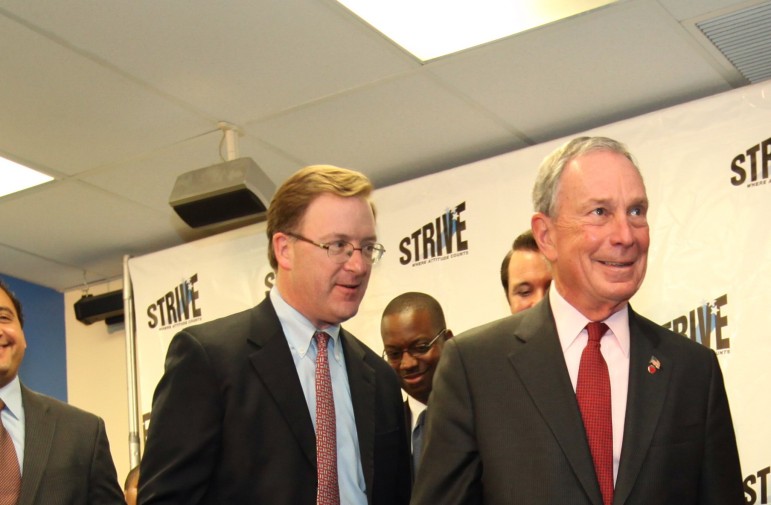
Office of the Mayor
Then-HRA Commissioner Robert Doar at left with Mayor Bloomberg in 2012.
It’s only Tuesday, but the Irony of the Week Award might already be sewn up. The winner: former Human Resources Administration Commissioner Robert Doar complaining about a rise over 2014 in the number of New York City residents receiving welfare.
“This growth at a time when the economy is strong is concerning to those who care about a work-focused welfare system,” Doar told The New York Post.
The irony, of course, is that Doar never seemed concerned when the opposite was true: when, on his watch at HRA, the welfare rolls either dropped or remained steady despite a crushing recession in which unemployment soared, food-pantry lines lengthened and a small city took up residence in New York’s homeless shelters.
What’s happening now is likely the echo of what didn’t happen—but was supposed to happen—back in 2008 and 2009. The safety net is designed to respond to human need. It often didn’t under Doar’s supervision, so there’s a backlog. De Blasio and his HRA boss Steve Banks are playing catch-up, because the improvement in the economy hasn’t been felt by everyone. (The author of the Manhattan Institute report that prompted the Post‘s story notes, by the way, that despite the 2014 increase, the city’s welfare rolls remain low by historical standards.)
There are two ways to reduce welfare use. One is to deny people benefits to which they are entitled or sanction them off the rolls for bureaucratic missteps. The other is to try to reduce the poverty that drives people to ask for help. And a different report out this week charts a policy path for doing just that by bringing the city’s poverty rate to 6.7 percent.
According to the Urban Institute—in research supported by the Federation of Protestant Welfare Agencies, Catholic Charities Archdiocese of New York, and UJA-Federation of New York—that transformative reduction would be the result if New York City implemented a package of new or enhanced anti-poverty programs.
The anchor of the effort would be a transitional jobs program to temporarily subsidize work for people currently un- or under-employed. Add to that subsidized childcare, a senior and disability tax credit, better housing vouchers, more generous food stamps, a $15-an-hour minimum wage and a beefed up Earned Income Tax Credit, and you get a 69 percent reduction in the poverty rate.
You also get a $9.1 billion price tag, which is very large. But the report analyzes two slightly less ambitious policy packages that offer smaller costs, as well as less dramatic policy reductions.
What comes through clearly, however, across the options weighed is that combining policies is critical. On their own, none of the individual policies makes nearly as big a dent as the combo does.
In a conference call with reporters on Monday, the report’s sponsors said they were set up to talk to the de Blasio administration about their ideas and beginning a parallel conversation with the governor.
Until those conversations happen, the city’s welfare rolls may swell a little more. After all, you can’t eat irony.









One thought on “As Some Fret Over NYC’s Welfare Rolls, Others Aim to Attack Its Poverty”
Pingback: What's Brewing? This Week's Must Read Link Roundup - The BQ Brew